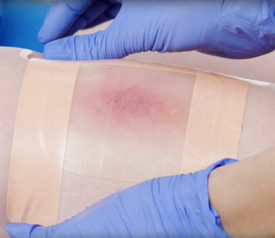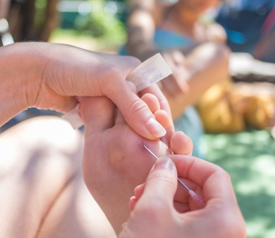To waterproof a wound for swimming, you need to protect it properly. This ensures the wound stays dry and reduces infection risk.
In this guide, we’ll explore simple steps to keep your wound safe in water. Swimming is a fun and healthy activity, but having a wound can complicate things. Water can carry bacteria, increasing the chance of infection if the wound is not covered well.
Whether it’s a small cut or a recent surgical site, protecting your wound is crucial. This article will provide easy and effective methods to waterproof your wound. By following these steps, you can enjoy swimming without worrying about your injury. Let’s dive in and learn how to keep your wound dry and safe in the water.
Importance Of Waterproofing A Wound
Waterproofing a wound is crucial before swimming. Water exposes wounds to bacteria and other contaminants. Protecting wounds prevents serious infections. Let’s explore why it’s important to waterproof a wound before swimming.
Preventing Infections
Water contains many bacteria and germs. These can easily enter an open wound. This increases the risk of infections. Waterproofing the wound creates a barrier. This keeps harmful elements out.
Infections can slow down the healing process. They can cause complications. In severe cases, they might lead to more serious health issues. So, keeping the wound dry is key to avoiding infections.
Promoting Faster Healing
A wound heals best when it’s clean and dry. Moisture can delay the healing process. It can cause the wound to reopen. Waterproofing ensures the wound stays dry. This creates a better environment for healing.
Swimming with an unprotected wound can cause irritation. Chlorine in pools can be harsh on open wounds. Saltwater can also cause discomfort. Waterproofing helps prevent these issues. It promotes faster and more comfortable healing.

Credit: medicalmonks.com
Choosing The Right Waterproof Bandage
Choosing the right waterproof bandage is crucial for protecting your wound while swimming. A good waterproof bandage keeps your wound dry and safe. It prevents infection and promotes healing. Here are some key points to consider.
Types Of Waterproof Bandages
There are different types of waterproof bandages available. Adhesive bandages are common and easy to use. They come in various sizes and shapes. Hydrocolloid bandages create a moist environment for faster healing. Transparent film bandages are thin and flexible. They stick well to the skin and provide a clear view of the wound.
Features To Look For
Look for a bandage that sticks well to the skin. It should stay in place even when wet. Breathability is important too. The bandage should allow air to reach the wound. This helps prevent moisture buildup and reduces the risk of infection. Comfort is another key feature. The bandage should not cause irritation or discomfort.
Additionally, check for the size and shape of the bandage. It should cover the wound completely. This prevents water from entering and keeps the wound dry. Lastly, ensure the bandage is easy to apply and remove. This makes the process hassle-free and quick.
Applying A Waterproof Bandage
Swimming with an open wound can be risky. A waterproof bandage can protect your wound from water. This helps in faster healing and prevents infection. Below are the steps to apply a waterproof bandage effectively.
Preparation Steps
Before applying the bandage, gather all the necessary items. You will need:
- A waterproof bandage
- Antiseptic solution
- Gauze or cotton pad
- Clean towel
Wash your hands with soap and water. Dry them with a clean towel. Clean the wound with an antiseptic solution. Pat the wound dry with a gauze or cotton pad.
Proper Application Techniques
To apply the waterproof bandage, follow these steps:
- Remove the bandage from its packaging.
- Peel off the backing to expose the adhesive.
- Place the bandage over the wound, ensuring it covers the entire area.
- Press down on the edges to secure the bandage.
Make sure there are no air bubbles under the bandage. This ensures a tight seal. If the bandage becomes loose, replace it immediately. Check the bandage after swimming to ensure it is still in place.
In some cases, you may need to change the bandage daily. This depends on the size and type of the wound. Always follow your doctor’s advice.
Additional Waterproofing Methods
When it comes to swimming with a wound, ensuring it stays dry is crucial. Standard bandages may not provide enough protection against water. That is why additional waterproofing methods can be essential. These methods offer better security and peace of mind while swimming.
Using Waterproof Tape
Waterproof tape can be a reliable option to protect wounds while swimming. First, clean and dry the wound area. Then, apply a standard bandage. Ensure it covers the entire wound. Next, take the waterproof tape and carefully wrap it around the bandage. Make sure to cover all edges. This creates a tight seal to keep water out. Waterproof tape is easy to find in most drugstores. It is also simple to use. Always check the seal before entering the water.
Applying Liquid Bandage
Liquid bandage is another effective method for waterproofing wounds. It is a special adhesive that forms a protective layer over the wound. Start by cleaning and drying the wound area. Then, apply the liquid bandage directly to the wound. Allow it to dry completely. This usually takes a few minutes. Once dry, it forms a waterproof barrier. Liquid bandage is ideal for small cuts and abrasions. It is also less bulky than traditional bandages. Remember to reapply if the layer starts to peel off.
Testing The Waterproof Seal
Testing the waterproof seal of a wound cover is crucial. It ensures your wound stays dry while swimming. This guide explains the steps for testing the seal effectively.
Visual Inspection
First, check the waterproof cover. Look for any visible gaps or tears. Ensure the adhesive edges are firmly attached to your skin. A loose edge can let water in. Make sure the cover lies flat against your skin without wrinkles. Wrinkles can create weak points in the seal. Take your time with this step. A good visual inspection prevents many problems.
Water Immersion Test
Next, perform a water immersion test. Fill a basin with water. Submerge the covered wound for a few minutes. Watch for air bubbles. Bubbles mean water is entering. If no bubbles appear, gently press the cover to feel for leaks. If the cover stays firmly in place and no water seeps in, your seal is likely effective. Repeat this test to be sure.

Credit: hytape.com
Post-swim Wound Care
Protecting wounds while swimming involves using waterproof dressings or bandages. These create a barrier against water, keeping the wound dry. Always ensure the bandage is secure before entering the pool.
Taking care of your wound after swimming is crucial. This ensures proper healing and prevents infections. Follow these steps to maintain your wound’s health.Removing The Bandage
Start by washing your hands thoroughly with soap and water. This prevents germs from transferring to the wound. Gently peel off the waterproof bandage. Try to avoid pulling or tugging on the skin. Dispose of the used bandage properly.Cleaning And Dressing The Wound
Clean the wound gently with mild soap and water. Avoid using harsh chemicals or scrubbing too hard. Pat the area dry with a clean towel. Apply an antiseptic ointment to reduce the risk of infection. Cover the wound with a fresh, sterile bandage. Make sure the bandage is secure but not too tight. Proper post-swim wound care is vital for healing. Follow these steps after every swim session. “`Common Mistakes To Avoid
Waterproofing a wound for swimming requires care and attention. Many people make common mistakes that can lead to infections or prolonged healing. Avoid these errors to keep your wound safe while enjoying the water.
Using Non-waterproof Bandages
Using regular bandages is a major mistake. These bandages are not designed to keep water out. Water can seep through and infect your wound. Always use bandages labeled as waterproof. They are made to stay dry even when submerged.
Check the packaging before buying. Ensure it says “waterproof” or “water-resistant.” Apply the bandage correctly. Make sure it fully covers the wound. Press firmly around the edges to seal it. This helps keep water out and protects your wound.
Ignoring Warning Signs
Ignoring signs of infection or irritation is risky. Redness, swelling, or pus are warning signs. Stop swimming if you notice these. Seek medical advice immediately. Your wound may need extra care.
Check your wound daily. Look for changes in color or size. If it looks worse, avoid swimming. Protecting your health should be your priority. Keeping an eye on the wound helps you act quickly if problems arise.
Following these tips can help you avoid common mistakes. Keep your wound safe and enjoy swimming without worry.

Credit: www.220triathlon.com
Expert Tips For Long-lasting Protection
Ensuring that a wound stays dry while swimming can be tricky. Water can introduce bacteria and hinder the healing process. To help, here are some expert tips for long-lasting protection when waterproofing a wound.
Layering Techniques
Layering is key to keeping a wound dry. Start with a waterproof bandage. Make sure it’s the right size to cover the wound completely. Next, use medical tape around the edges to seal it.
For extra protection, add a layer of plastic wrap. Wrap it snugly around the bandage. Use more medical tape to secure it. This creates a barrier against water.
If you need even more protection, wear a waterproof sleeve or cover. These are made for swimming and provide an extra layer of defense.
Reapplying As Needed
Over time, the layers can shift or lose their seal. Check the wound cover often. If it looks loose or wet, reapply the layers.
Keep extra bandages, tape, and plastic wrap in your swim bag. This way, you can reapply them quickly if needed.
After swimming, remove the waterproof layers. Clean the wound and apply a fresh bandage. This keeps the wound clean and helps it heal faster.
| Step | Material | Purpose |
|---|---|---|
| 1 | Waterproof Bandage | Initial wound protection |
| 2 | Medical Tape | Seal edges |
| 3 | Plastic Wrap | Extra barrier |
| 4 | Waterproof Sleeve | Final protection |
Frequently Asked Questions
How Can I Swim With A Wound?
To swim with a wound, you must waterproof it. Use waterproof bandages or dressings specifically designed for this purpose.
Are Waterproof Bandages Effective?
Yes, waterproof bandages are effective. They protect wounds from water and prevent infections while swimming.
Can I Use Plastic Wrap For Waterproofing?
Plastic wrap is not recommended for waterproofing wounds. It may not provide a secure seal and can cause irritation.
How Do I Apply A Waterproof Dressing?
Clean and dry the wound first. Then, apply the waterproof dressing securely, ensuring it covers the wound completely.
Conclusion
Waterproofing a wound for swimming is essential. Follow the steps mentioned for safety. Clean the wound. Use waterproof bandages or covers. Secure the edges with medical tape. Check for leaks before swimming. With these precautions, you can swim safely. Always monitor the wound post-swim.
If irritation occurs, seek medical advice. Enjoy your swim without worries. Stay safe and healthy!



